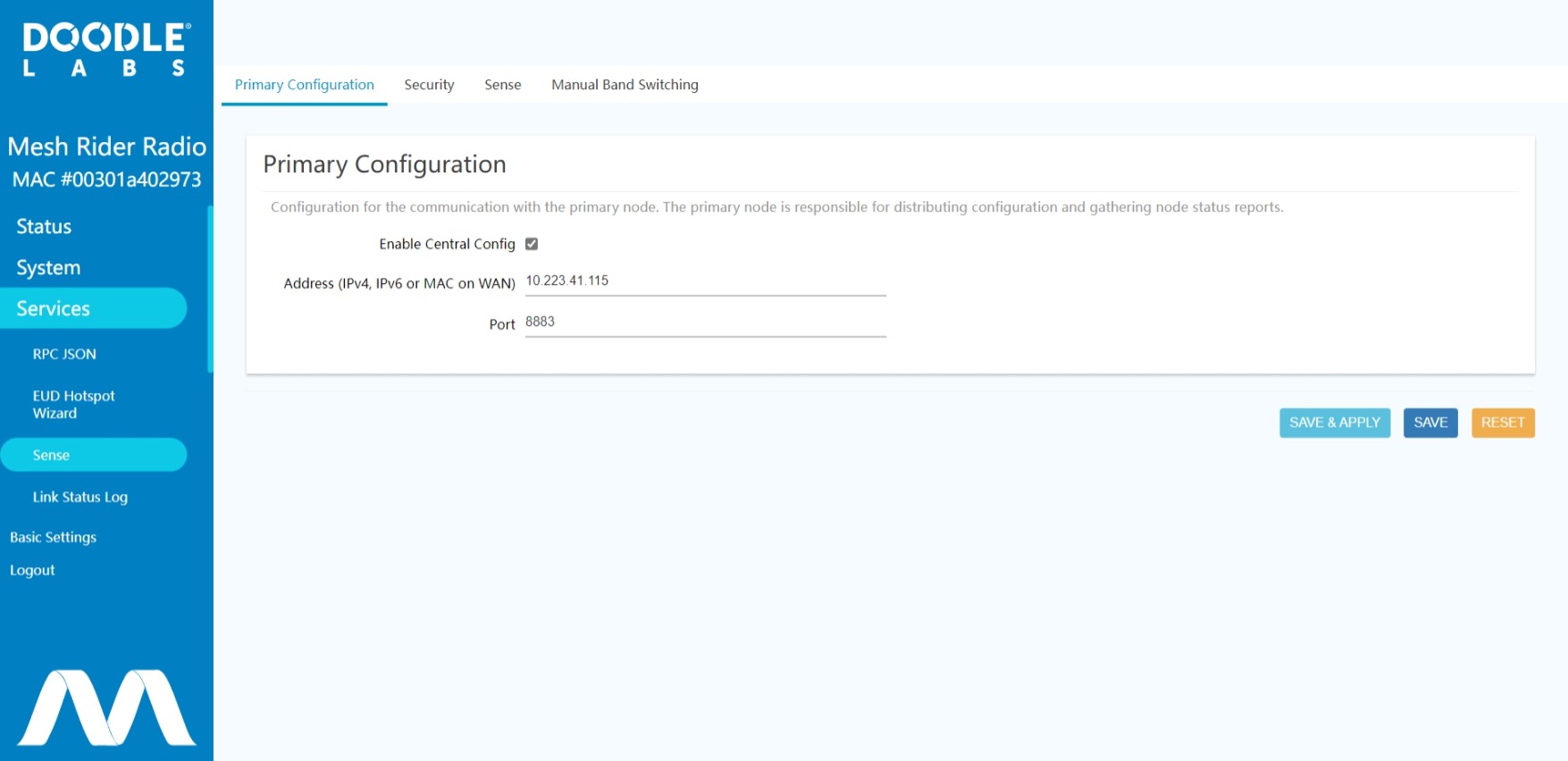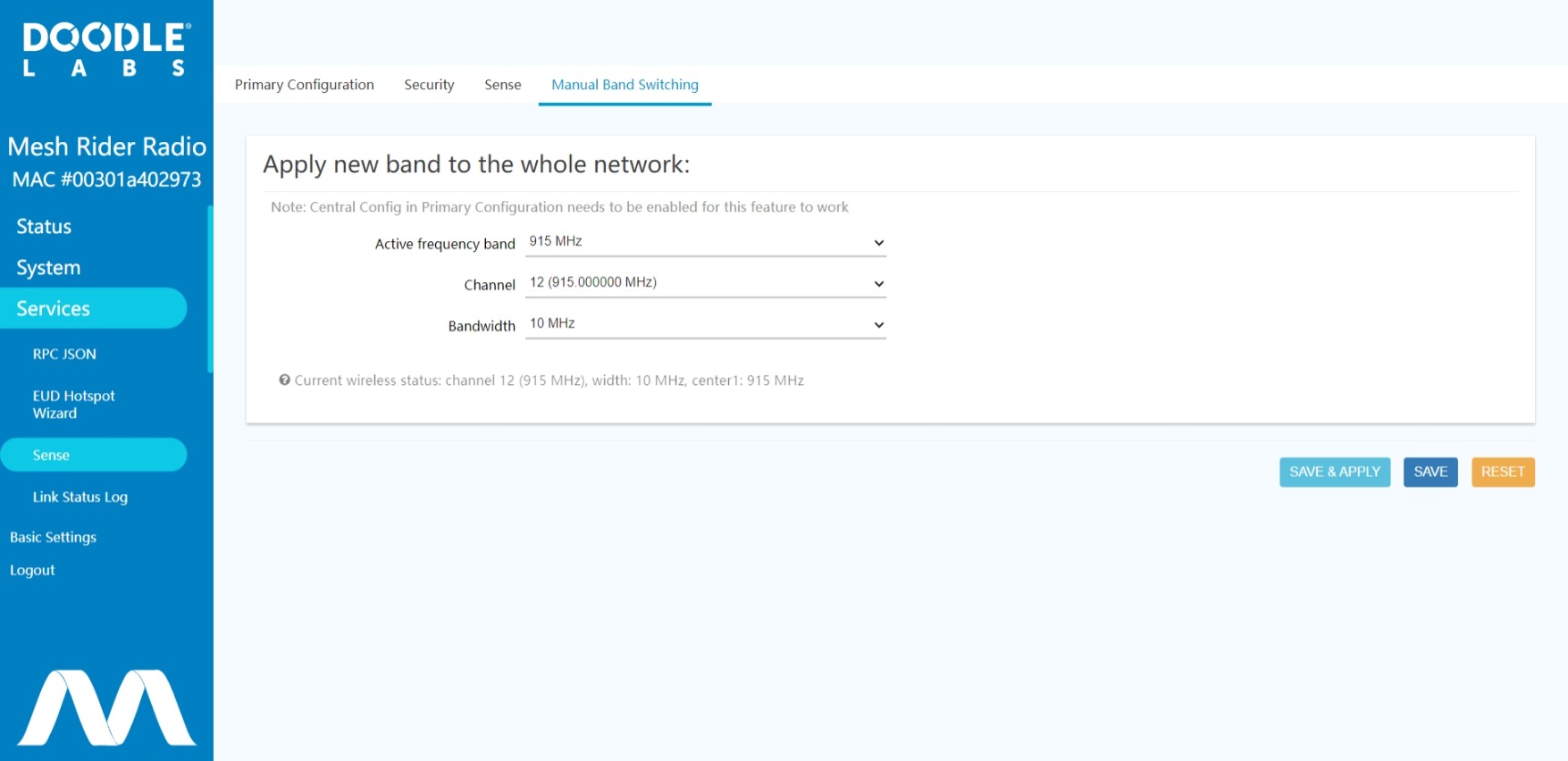Sense
Introduction
Sense is the name of our upgraded Central Configuration, automatic band/channel/bandwidth selection, and link recovery utility. Sense was introduced in the July 2023 Beta Resilience Release and underwent a major update for the September 2023 Sense release.
A license is required to use Sense's automatic band/channel/bandwidth selection protocol. Contact a Doodle Labs Sales Representative for more information.
Without a license it is only possible to make manual band/channel/bandwidth changes through either the GUI or the JSON-RPC/UBUS API. This is discussed in further detail below.
Automatic Band/Channel/Bandwidth Selection
The automatic band/channel/bandwidth selection is only enabled with a software license. It consists of two main parts.
- Link monitoring. The link is constantly monitored, and when the link performance crosses a threshold, the network will switch to a different band/channel/bandwidth.
- Link recovery. If the link is broken for any reason, the radios will use Sense's link recovery protocol to re-establish a connection.
For more information on Sense licensing, configuration, and usage, please contact a Doodle Labs Sales Representative.
Manual Band/Channel/Bandwidth Selection
Without a Sense license, it is still possible to make manual band/channel/bandwidth changes through either the GUI or the JSON-RPC/UBUS API. If you have a Sense license, you can also make manual band/channel/bandwidth changes with Sense running.
Setup the messaging system
In the current version, Sense uses our Central Config system for messaging, which is based on MQTT. In the messaging system, there is one master or primary node, and there can be multiple clients (currently only one is allowed, or Sense will stop). All messages need to go through the primary node, which disseminates the messages to all clients. Navigate to Services -> Sense (Fig. 1).

Fig. 1 Sense main configuration Menu
The primary node is selected by inputting its address (IPv4, IPv6, or MAC) in the Primary Configuration tab and clicking Save & Apply. The Sense utility uses TLS for security, and this can be configured in the Security tab. The messaging system can also be set up using uci.
root@smartradio:/# uci show central_config
central_config.@primary[0]=primary
central_config.@primary[0].enabled='1'
central_config.@primary[0].primary_addr='10.223.41.115'
central_config.@primary[0].primary_port='8883'
Changing channels through the GUI
To switch to a different band/channel/bandwidth through the GUI, use the Manual Band Switching tab in the Sense menu.

Fig. 1 Sense Manual Band Switching
Changing channels through the UBUS API
You can also execute a manual band/channel/bandwidth switch using the ubus command below. Ubus commands can be executed remotely over the JSON-RPC API.
$ ubus call central-config config '{"dest":"all","delay":0,"config":{"channel":"50","bandwidth":"5","submodel":"RM-1675-2L-X"}}'
Here we are switching to channel 50 with a bandwidth of 5-MHz, using the submodel RM-1675-2L-X. You can get a list of valid submodels by running the following command (output shown)
$ cat /usr/share/.doodlelabs/fes/$(fes_model.sh get parent)
sub_model0="RM-1675-2L-X"
sub_model1="RM-1815-2L-X"
sub_model2="RM-2065-2L-X"
sub_model3="RM-2245-2L-X"
sub_model4="RM-2350-2L-X"
sub_model5="RM-2455-2L-X"
sub_model6="RM-2450-2L-X"
You can check the current band settings using
$ iw wlan0 info
Interface wlan0
ifindex 9
wdev 0x2
addr 00:30:1a:4e:bb:02
type mesh point
wiphy 0
channel 51 (1675 MHz), width: 10 MHz, center1: 1675 MHz
txpower 36.00 dBm
multicast TXQ:
qsz-byt qsz-pkt flows drops marks overlmt hashcol tx-bytes tx-packets
0 0 39719 0 0 0 0 3825875 39846
In the example above, you can see that the radio is on channel 51 (1675 MHz), with a bandwidth of 10 MHz. You can check the connectivity to other nodes using
$ batctl o
[B.A.T.M.A.N. adv 2021.0-openwrt-1, MainIF/MAC: wlan0/00:30:1a:4e:bb:02 (bat0/4a:50:6e:97:51:a7 BATMAN_IV)]
Originator last-seen (#/255) Nexthop [outgoingIF]
* 00:30:1a:4e:bb:01 0.060s (246) 00:30:1a:4e:bb:01 [ wlan0]
In this case, there is one other radio in the network (00301a4ebb01), and the last packet received from it was 60ms ago. The transmit quality is 246/255 which is very good, and as it is the only other radio in the network, the Nexthop is directly to the other radio over the wlan0 interface.